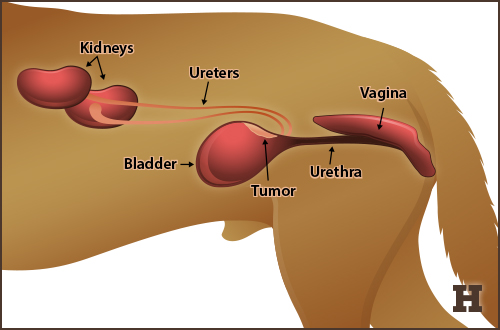Understanding and Successfully Treating Bladder Cancer in Dogs
Canine bladder cancer is a very aggressive type of dog cancer that’s found in the walls of the urinary tract. There are multiple types of bladder cancers, some start out in the bladder, while others may have metastasized to the bladder. The most common type of bladder cancer found in dogs is transitional cell carcinoma (TCC).
 Symptoms can be similar to urinary tract infections and bladder stones. As a result, misdiagnosis can occur and it may be months before bladder cancer is properly diagnosed.
Symptoms can be similar to urinary tract infections and bladder stones. As a result, misdiagnosis can occur and it may be months before bladder cancer is properly diagnosed.
Main Causes for Bladder Cancer in Dogs
There’s been a rise in many types of cancers of the intestines, such as stomach cancer in dogs. Though it’s difficult to know for certain, it’s commonly agreed that exposure to pesticides, herbicides and other toxins is the major factor.
Diet also plays a role in the development and promotion of many intestinal illnesses as well as canine bladder cancer. A properly functioning digestive tract is the key to maintaining health. Unfortunately, many commercially manufactured dog foods can cause a number of digestive challenges leading to the development of more serious issues.
 Dry dog foods actually dehydrate the digestive tract and fail to properly flush out contaminants and pollutants from the intestines and bladder.
Dry dog foods actually dehydrate the digestive tract and fail to properly flush out contaminants and pollutants from the intestines and bladder.
Diagnosis
There’s a number of different methods to help diagnose bladder cancer depending on the age breed and symptoms of the dog. For middle ages dogs that are predisposed to canine bladder cancer, a Antigen test (urine test) can be helpful for an initial screening.
An Ultrasound of the abdominal region can evaluate the lymph nodes as well as helping to detect a mass on the bladder wall.
A Contrast Cystography is a very effective type of X-ray that uses a contrasting agent injected into the bladder to help detect a mass.
On female dogs, a Cystoscopy (camera inserted into the bladder) can be used to provide a visual evaluation, as well as obtain a sample for biopsy.
Prognosis
This type of cancer is often in its advanced stages before it’s detected making the survival rate very low. If surgical removal of the tumor is not an option, Piroxicam combined with chemotherapy can help extend life for around 8-12 months.
Canine Bladder Cancer Symptoms:
- Straining to urinate
- Frequent urination
- Blood in urine
- Licking the penis or vulva
- Decrease in appetite
- Redness or swelling at the penis tip or vulva
- Continued weight loss
- Painful abdomen

Piroxicam is a non-steroidal anti-inflammatory drug (also known as an NSAID) that has offered benefit both in alleviating symptoms due to inflammation in many dogs, as well as causing actual tumor shrinkage in some dogs.
Conventional Treatments for Bladder Cancer in Dogs
Unfortunately transitional cell carcinomas usually have become quite large by the time they are diagnosed, and with conventional treatments by themselves, the prognosis is only a few months.
Surgical removal may be an option if the tumor is localized to a specific area, however this is not a common option. Generally, the best that conventional treatments have to offer at the moment is Chemotherapy, Radiation, and a drug called Piroxicam, which is a nonsteroidal anti-inflammatory drug (NSAID) that can improve the quality and quantity of life for dogs.
Chemotherapy can be used, such as doxorubicin, piroxicam, mitoxantrone or vinblastine, but the response is generally not as good as with some other types of cancers in dogs.
Radiation therapy is more expensive procedure that can be used in some cases, but side effects with urination can cause complications. Full course radiation therapy (15-18 treatments) often causes scarring of the bladder which can severely impact the quality of life. Palliative (pain-relieving) radiation is well tolerated and may temporarily improve symptoms.
Laser therapy is not very common, but may also be an available as a means of locally controlling the cancer and is quite effective help dogs with their urinary functions.
Holistic Treatments for Bladder Cancer in Dogs
Diet is obviously an important component when treating any type of cancer, but even more so when addressing a cancer of the intestinal tract such as canine bladder cancer.
Just as an improper diet has strong adverse affects on the intestines, a powerful cancer diet treatment can begin to help heal right at the source of the problem. The bladder will come into direct contact with the immune boosting nutrients and cancer fighting herbs.
Flushing and cleansing the digestive tract of toxins, and constructing a powerful dietary program are key elements for successfully treating bladder cancer in dogs.
Holistic cancer treatments for dogs tend to address more than just the tumors. They also take a strong consideration into the overall health of the patient as well as the the underlying issues that have lead to the development of the disease.
Whether conventional methods are being used or not, to attain and maintain remission, the proper diet treatment is crucial. There are a number cases where long term remission was attained sometimes with a holistic diet treatment alone, such as with Henry’s Story.
Is it a Case of Faulty Genes?
In the vast majority of cases, absolutely not. Some types of cancer are more common it certain breeds as they may be more predisposed. Bladder cancer tends to be more common in Scottish Terriers, West Highland White Terriers, Beagles and Shetland Sheepdogs. However, it’s important to understand that predisposed does not mean predetermined! Genetics are a factor, but there are many other factors as well.
For cancer, or any disease to develop, a dysfunction in the immune system must be present. So by addressing this area, we can greatly reduce illness regardless of what genetic challenges a certain breed has.
Many dogs have these same “weak links” and go on to live healthy and full lives, while some unfortunately do not. Genes are merely blueprints, and it’s how well these these blueprints are constructed and maintained that makes the difference.
All that being said, when a breed is more predisposed, this simply means that when something is challenging the immune system, the weakest genetic link is where we often find the effects first. The bladder is in direct contact with digested contaminants, and over time, these poisons take their tole on the bladder as well as other areas of the body.




